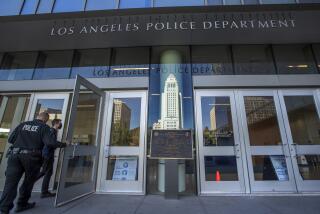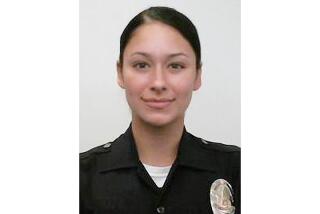LAPD Prevails Over Civilian Overseers
LAPD disciplinary boards have overturned the city’s Police Commission at least four times in recent years, allowing officers to escape punishment for shootings that the department’s civilian bosses ruled improper, a Times investigation has found.
Even in shooting cases in which there was no dispute between the police boards and the commission, penalties were often no more severe than might be imposed when an officer lost a piece of equipment, failed to show up in court or got into a traffic accident. Moreover, the LAPD has struggled for years to develop specific punishment guidelines and has meted out inconsistent penalties in shooting cases.
In a pair of shootings that occurred just months apart in 2000, for instance, one officer violated department policy when he shot and killed an unarmed man. A few months later, another broke the same rules when he shot a dog. The officer who shot the dog was given the heavier penalty.
Los Angeles’ mayor, the former inspector general of the LAPD and members of the Police Commission are among those questioning a system that some view as dangerously capricious. In addition, Police Chief William J. Bratton and Police Commission President Rick Caruso contend that police disciplinary panels, known as boards of rights, have undermined civilian oversight of the LAPD and limited the chief’s authority to manage the institution.
“The system makes no sense,” Caruso said last week. “I think it should be disbanded and a new one put in place.”
The department’s disciplinary system received new scrutiny last week after the disclosure that the officer who fatally shot a homeless woman, Margaret Mitchell, in 1999 had not been punished, although the civilian Police Commission had determined that he should have been.
The Times, as part of an investigation of LAPD shootings, has identified three other recent shootings that, like the Mitchell case, were found “out of policy” by the Police Commission but in which the commission’s findings were then effectively overturned by members of internal disciplinary panels, with the result that the officers involved were not punished.
In a fifth case, which the city paid $1.1 million to settle, the officer was given an “official reprimand” as punishment, but that was later rescinded by the chief of police. All but one of the officers involved in the shootings remain on the force.
At the LAPD, a police shooting is investigated by a special team of detectives. Those investigators interview witnesses, collect evidence and compile a report, which is forwarded to a shooting review board. That board analyzes the incident to assess the officer’s tactics leading up to the shooting and the decision to fire the gun. The police chief determines, on the basis of their work, whether the officer’s tactics were sound and whether the shooting complied with department rules.
The Police Commission then considers the chief’s analysis and makes the final determination on the propriety of the shooting. If the commission rules that a shooting violated policy, its members say, they expect discipline to be imposed. Such instances are referred from the commission back to the police chief. If the chief is seeking a long suspension or dismissal, he refers the case to a board of rights, made up of two LAPD command officers and one civilian. Any officer can also request a hearing before a board of rights. Although it comes after the commission’s consideration of the case, the board of rights hearing is the first step in the process in which an accused officer is given the opportunity to mount a defense and to cross-examine any witnesses testifying against him. The chief, under LAPD rules, may reduce the punishment imposed by a board but may not increase it.
In most cases, boards accept the judgment of the commission and impose some form of punishment. But in some, such as the Mitchell case, board members have defied the commission, the chief, or both.
In 1999, for instance, Officer Wayne Cespedes and a partner were responding to a radio call about a man who was believed to be either mentally ill or under the influence of drugs or alcohol. When Cespedes saw what he thought was a knife in the suspect’s hand, the officer drew his gun and took cover behind the door of his police car, according to police documents. The suspect then stepped toward Cespedes, coming within about 22 feet of where the officer was standing, documents state. Fearing that he or his partner -- who was trying to retrieve a beanbag shotgun from the trunk of the police car -- was about to be stabbed, Cespedes fired twice. The suspect, later identified as 56-year-old Gus Woods, died from a shot to the chest. Investigators later discovered that he had been holding an 8 1/2-inch metal rod.
Then-Chief Bernard C. Parks, noting that Cespedes had cover and that Woods had been more than 20 feet away and appeared to have been intoxicated, concluded that “the suspect did not present an immediate threat of death or serious bodily injury.” Parks recommended that the shooting be found “out of policy.” The Police Commission agreed.
The LAPD disciplinary board that considered the case saw it differently. The board, led by Cmdr. George Gascon, found Cespedes not guilty.
The board based its decision, in part, on a video Cespedes had been shown while he was a patrol officer. A sergeant who is a use-of-force expert at the Police Academy testified that several officers who had been shown the video at training sessions in the early 1990s walked away from it with the impression that any suspect who was armed with an edged weapon, such as a knife, and who came within 21 feet represented a threat justifying the use of deadly force. The sergeant told board members that he was so concerned about the officers’ misinterpretation of the tape that he went to a supervisor and had it removed from the department’s training program.
Gascon, who has since been promoted to assistant chief in charge of LAPD training, said it would have been unfair to punish the officer for doing something that he thought he had been trained to do, even if that training turned out to be misguided.
In another case, 77th Street Division Officer Luis Navarrete was responding to a burglary call May 31, 2000, when he said a man came at him with what he thought was a half-gallon glass bottle raised above the man’s head, according to the Police Commission’s summary of the incident.
“Believing that the suspect was about to strike him on the head,” the summary states, “Navarrete fired one round.” The bullet missed. The suspect was arrested and booked on suspicion of assault with a deadly weapon.
But shooting investigators became suspicious of Navarrete’s account after interviewing the suspect and the only other known civilian witness to the shooting, the man who had called police to report a possible burglary in the first place. That witness said it had appeared to him that the suspect, whose bottle turned out to be plastic, had been a bystander and that Navarrete had fired at him by accident.
Chief Parks concluded that Navarrete might not have been truthful and, in an analysis of the shooting, wrote, “I believe that Officer Navarrete may have become startled and accidentally fired one round.” He recommended to the Police Commission that the shooting be found “out of policy.” Commissioners agreed.
Once again, however, the LAPD disciplinary panel that heard the case did not. Navarrete was found not guilty and, as a result, received no punishment.
Navarrete, who is back on patrol in the 77th Street Division, said in a brief interview with The Times that he had been relieved by the board’s decision. “I was telling the truth from the very beginning,” he said. “I was right and everyone else was wrong.”
Although boards have on several occasions overturned the commission, delays in the department’s investigative process also have at times rendered the commission’s work irrelevant. In 2000, for instance, the Police Commission concluded that Officer Karen Thiffault had improperly shot and killed a 16-year-old boy who was naked and under the influence of drugs when the officer said he tried to take her pistol.
More than a year passed between the incident and the completion of the LAPD investigation into it. That exceeded the statute of limitations for police discipline, so Thiffault was given only a reprimand for the fatal shooting, even though the commission found that it had violated LAPD rules. Interim Chief Martin Pomeroy rescinded the reprimand, cleaning the officer’s record of the offense.
The boy’s family sued, and the city attorney’s office settled the case for $1.1 million.
Punishing officers in shooting cases, LAPD officials said, is a difficult task. They want to send a message that shooting mistakes are serious infractions with grave consequences, but at the same time not be overly harsh with officers who have made poor, split-second decisions while being thrust into life-or-death confrontations.
From 1985 to 2001 -- the last year for which complete statistics are available -- police commissioners concluded that officers violated department rules on the use of deadly force more than 500 times, about one of every five times an officer fired a gun. More than half of those shootings were accidents, which almost always are ruled improper. When officers intentionally fired at suspects, they unjustifiably used deadly force one time out of every 12, records show.
“An out-of-policy shooting that results in the death of a human being should be taken very seriously,” Mayor James K. Hahn said in an interview. “I think the people expect that there ought to be some consequence for doing something wrong that causes injury or death to somebody else.”
When LAPD commanders agree that discipline should be imposed in shooting cases, the punishments are often uneven.
For example, in 2000 off-duty Officer Jose Cortez-Amaya shot and killed an unarmed man trying to sell him a stolen ring at a hamburger stand. His punishment: a two-day suspension.
Months later, Officer Paul Mosley shot and killed a bulldog that was fighting with another dog. That shooting, the department concluded, warranted a three-day suspension.
When Officer Jamie Bennett shot at, and missed, a 14-year-boy who shone a red laser light at him in 2000, supervisors concluded that the shooting was out of policy and he was suspended for two days.
Officer Ernest Berry shot at, and missed, a fellow officer that he mistook for a suspect in 1999. His actions also were ruled improper, but he received a 15-day suspension.
Department officials and others said that is, in part, because there is little guidance for LAPD commanders who are responsible for recommending an officer’s punishment to the chief.
In 2001, when a departmentwide disciplinary guideline was established to help standardize penalties for officer misconduct, the recommended punishments for shooting offenses ranged from an admonishment to termination, the entire scope of available discipline. Penalties for accidental discharges were more limited, with the recommended punishment for a first offense starting at an admonishment and going up to a four-day suspension if there are no injuries. The punishment could rise to nine days if there were injuries.
At the Los Angeles County Sheriff’s Department, by contrast, the guidelines are far narrower. They propose a five- to 10-day suspension for officers guilty of “unreasonable force” if the offense is the officer’s first. If an officer is found guilty of using “significant unreasonable force,” the penalty ranges from a 10-day suspension to termination, records show.
LAPD officials said some factors can significantly increase an officer’s penalty for a shooting offense. They include lying during the investigation, alcohol-related violations and repeated unreasonable use of force or other misconduct.
Yet, a review of specific cases in recent years suggested that, even under those circumstances, it is rare for an officer to be fired. Over the years, officers who have faked their own suicides, mistakenly shot relatives, accidentally killed unarmed suspects and covered up accidental off-duty shootings have kept their jobs.
Det. Charles Choe, for instance, had two out-of-policy, off-duty shootings, both of which involved drinking. In 1988, he randomly fired his gun into the air as he walked home from a dinner party where he had consumed at least eight beers and five straight shots of cognac.
Local police detained Choe, and the LAPD suspended him for 10 days. Seven years later, Choe was drunk again when he shot out the window of a car belonging to the girlfriend of a friend with whom he was drinking. When police attempted to take Choe into custody, he allegedly reached for his backup weapon, which was strapped to his ankle. He was suspended for 129 days but kept his job.
In an interview, Choe said there had been no excuse for his misconduct.
“I had to look at myself and realize that I have a problem. I’m not ashamed to say I’m an alcoholic,” said the detective, who is now assigned to the Wilshire Division, where he has not had any other shootings. “I took steps to correct my problem.” He added: “Other people might not see it this way, but I did my time. I corrected my problem. And I think I’m a better man.”
Geoffrey Alpert, a professor of criminal justice at the University of South Carolina who specializes in police use of deadly force, said discrepancies in penalties undermine the credibility of a disciplinary system. The respective punishments given the officers in the shootings of the dog and the unarmed suspect, for instance, were “ridiculous,” he said.
He said he thought LAPD officials “may be falling down because they’re not distinguishing the type of policy violations, or human rights violations, according to seriousness of type. Life is more important than property.”
Comparing discipline imposed in one incident with that in another incident without considering such factors as an officer’s complaint history or the circumstances of an incident is “much too simplistic,” countered LAPD Deputy Chief Gary Brennan, who reviewed The Times’ findings. “Maybe there is no way to explain it to the extent that everybody is going to be satisfied. But that doesn’t mean our response should be penalties that we don’t believe are right to satisfy the public.”
Jeffery C. Eglash, the LAPD’s inspector general from 1999 to 2002, said he believed the department needed to do a better job in making sure that discipline imposed on officers corresponded to their misconduct. The LAPD, he said, should not be seen as placing more value on a dog’s life than a man’s.
“We get so immersed in the particulars of a case that we don’t sit back and look at the bigger picture,” said Eglash, now a private attorney. “We don’t sit back and look at punishments in one class of cases against another. We should do that.”
*
Times staff writer Doug Smith and researcher Offer Egozy contributed to this report.
More to Read
Sign up for Essential California
The most important California stories and recommendations in your inbox every morning.
You may occasionally receive promotional content from the Los Angeles Times.











